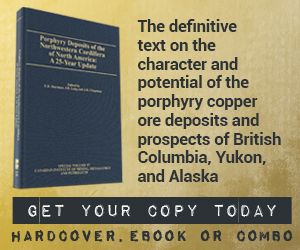Library Magazine Articles The centenary of Proved and Probable Reserves
The centenary of Proved and Probable Reserves
Ed Sides - Sep 2009
Most readers will be familiar with one or more of the codes that are recommended and, in many cases, legally required by relevant stock exchanges for the public reporting of Mineral Resources and Ore Reserves, including: PERC 2008 (Europe); SAMREC 2007 (South Africa); International Reporting Template 2006 (CRIRSCO); CIM 2005 (Canada); JORC 2004 (Australia and New Zealand); and Certification Code 2004 (Chile). For details, go to www.crirsco.com/national.asp.
All of these codes require a two-fold division of Ore Reserves (or Mineral Reserves) into Proved (or Proven) and Probable categories. A review of the evolution of reporting terminology highlights the fact that these terms have now been used in a similar context for exactly a century.
Little has been published on the reporting terminology used in the 19th century. However, a well-received paper published in 1901 on the usage of the term “ore in sight”1 gives several examples of the approaches and terminology used in the valuation of mining properties. The processes described by Kendall and contributors to the discussion on his paper are likely to reflect the practices used during the latter part of the 19th century. Following discussion of his paper, the Council of the Institution of Mining and Metallurgy (IMM) adopted a resolution requiring its members to standardize their usage of the term “ore in sight.”2
“That as the term “Ore in Sight” is frequently used to indicate two separate factors in an estimate, namely:
(a) Ore Blocked Out — that is Ore exposed on at least three sides within reasonable distance of each other — and (b) Ore which may be reasonably assumed to exist though not actually ‘blocked out.’
These two factors should in all cases be kept distinct, as (a) is governed by fixed rules, whilst (b) is dependent upon individual judgement and local experience.”
The IMM resolution also required that the data on which estimates of ore in sight were based should be presented in accompanying reports in the form of plans and sections (foreshadowing the transparency requirement of current codes), and that ore should meet the criterion of being “capable of being profitably extracted.” This resolution appears to mark the first attempt by a professional body in the mining industry to regulate the public reporting of estimates of the magnitude (and inherent value) of mineral properties.
Seven years later, Herbert Hoover published Principles of Mining3 in which he noted that the term “ore in sight” was considered to be too broad and that “The legitimate direction of reform has been to divide the general term of ‘ore in sight’ into classes, and give them names which will indicate the variable amount of risk of continuity in different parts of the mine.”
He went on to list some of the terms used in such classifications, namely:
- “Positive Ore / Ore Developed: Ore exposed on four sides in blocks of a size variously prescribed;
- Ore Blocked Out: Ore exposed on three sides within reasonable distance of each other;
- Probable Ore / Ore Developing: Ore exposed on two sides;
- Possible Ore / Ore Expectant: The whole or a part of the ore below the lowest level or beyond the range of vision.”
Hoover presented his preferred classification as:
- “Proved Ore: Ore where there is practically no risk of failure of continuity;
- Probable Ore: Ore where there is some risk, yet warrantable justification for assumption of continuity;
- Prospective Ore: Ore which cannot be included in the above classes, nor definitely known or stated in any terms of tonnage.”
Hoover concluded his discussion of “The Classification of Ore in Sight” with the following statement:
“Although the expression ‘ore in sight’ may be deprecated, owing to its abuse, some general term to cover both ‘positive’ and ‘probable’ ore is desirable; and where a general term is required, it is the intention herein to hold to the phrase ‘ore in sight’ under the limitations specified.”
From the above, it is noted that that the IMM’s pioneering resolution on professional reporting standards, which was adopted in September 1902, laid the foundation for the development of the reporting standards that are in current usage. Hoover’s textbook, published exactly a century ago, gave definitions of Proved and Probable Ore, which have survived in a similar context to the present day.
www.crirsco.com/national.asp References
- Kendall, J.D. (1901). Ore in sight (plus subsequent discussion). Transactions of the Institution of Mining and Metallurgy, Vol. X, 101-201.
- IMM (1902). Appendix: Ore in Sight. Transactions of the Institution of Mining and Metallurgy, Vol. X, 202.
- Hoover, H.C. (1909). Principles of Mining: Valuation, Organization and Administration. New York: McGraw Hill Book Company (available from http://www.gutenberg.org).
About the author
Ed Sides is a resource geologist with AMEC's Mining Services team in the United Kingdom. During his career, he has worked on various projects, from grassroots exploration through feasibility studies to operating mine. He has a special interest in the incorporation of geological controls into computerized resource estimation procedures.

.png)
